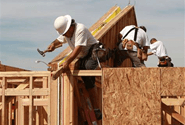Steel Markets

June's New Home Sales Fall to Lowest Rate This Year
Written by David Schollaert
July 26, 2021
Sales of new single-family homes fell in June for the fifth time in six months, landing at 6.6% below May’s downward revised estimate at a seasonally adjusted annual rate of 676,000, the U.S. Department of Housing and Urban Development and the U.S. Census Bureau reported on Monday.
Sales fell by 19.4% when compared to the same period last year, and were down 31.9% from the 12-month peak of 993,000 in January 2021.
June’s annual sales rate is the lowest since April 2020, yet despite the recent cooling trend new home sales are up 13.5% on a year-to-date basis when compared to the same period one year ago.
“The June data came in lower than expected, and we anticipate an upward revision next month,” said Robert Dietz, the National Association of Home Builders’ chief economist. “Nonetheless, sales have trended lower as construction costs have increased and builders have sought to manage material delays and cost challenges in the construction pipeline, in addition to dealing with shortages of lots and labor in many housing markets.”
The median sales price of new houses sold in June 2021 was $361,800, up 6.1% from a year ago. The average sales price in June was $428,700.
The inventory of new houses for sale at the end of June was an estimated 353,000 – a 6.3-month supply at the current sales rate. New single-family homes for sale were 46.5% higher than June 2020, but the inventory of homes available for sale but not yet under construction was up 84% year-over-year, a clear sign of supply-side limitations in the building market, according to the NAHB. In contrast, completed, ready-to-occupy inventory was down 44% year-over-year, to just 36,000 homes.
“Sales continued to trend lower in June as some builders slowed sales contracts to manage supply chains amidst longer delivery times and higher construction costs,” said Chuck Fowke, NAHB chairman. “While lumber prices have shown some improvement in spot markets, these declines take time to translate into lower construction costs. Moreover, other items like OSB remain elevated.”
Regionally, on a year-to-date basis, new home sales rose in all four regions, up 19.5% in the Northeast, 23.9% in the Midwest, 15.6% in the South and 4.1% in the West. These significant increases are due in part to lower sales volumes during the coronavirus health crisis a year ago.
By David Schollaert, David@SteelMarketUpdate.com

David Schollaert
Read more from David SchollaertLatest in Steel Markets

CMC looks beyond Arizona micro-mill woes to long-term viability of construction mart
Despite the economic and geopolitical upheaval of the last five years, CMC President and CEO Peter Matt points out that the construction market has been an essential element of the way forward.

US importers face stricter rules under revamped S232 tariffs
“CBP expects full compliance from the trade community for accurate reporting and payment of the additional duties. CBP will take enforcement action on non-compliance," the agency said in a March 7 bulletin.

Steel exports rebound in January
US steel exports recovered to a five-month high in January after having fallen to a two-year low in December. This growth follows four consecutive months of declining exports.

Construction spending drops marginally in January
Construction spending edged down slightly in January, slipping for the first time in four months. The US Census Bureau estimated spending at a seasonally adjusted annual rate of $2,196 billion in January, down 0.2% from December’s downward revised rate. The January figure is 3.3% higher than a year ago. January’s result, despite the slight erosion, […]

HVAC equipment shipments slow in December but strong annually
Shipments of heating and cooling equipment in the US fell to an 11-month low in December, according to the latest data released by the Air-Conditioning, Heating, and Refrigeration Institute (AHRI).
